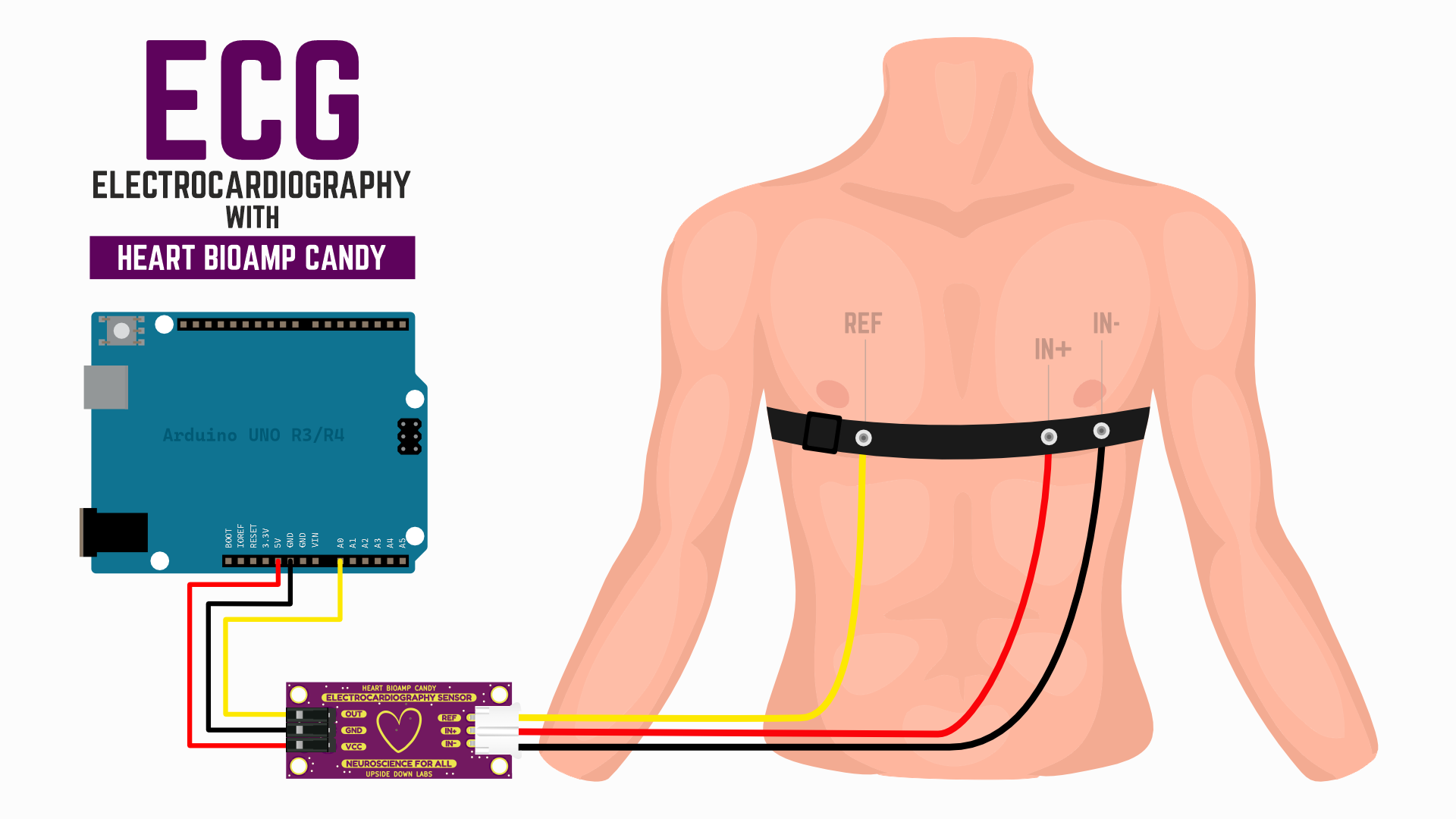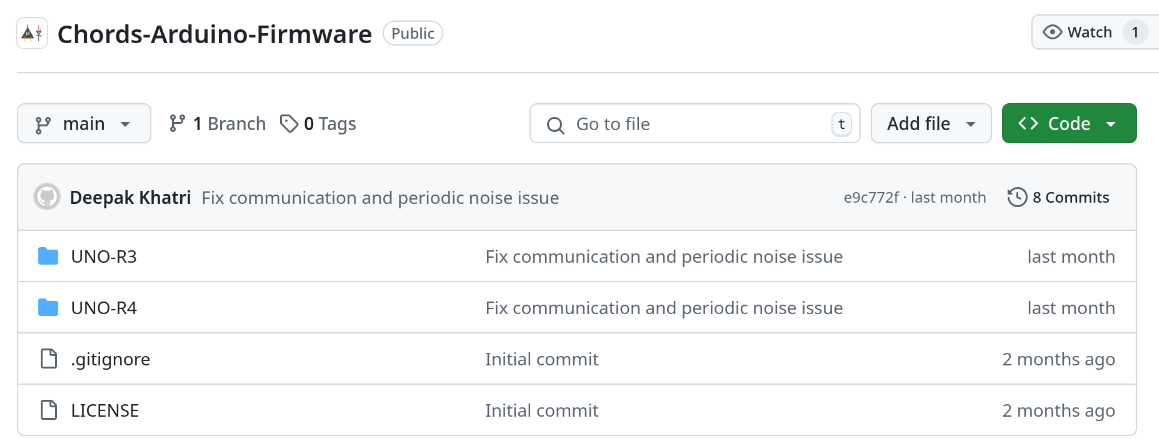Heart BioAmp Candy#
Overview#
Heart BioAmp Candy is a candy-sized sensor for recording ECG signals easily. It is perfect for students and researchers as it offers reliable and accurate ECG recordings, making heart monitoring accessible and convenient for educational and research purposes.

Heart BioAmp Candy#
Features & Specifications#
Input Voltage |
2.7 V - 5 V |
Fixed Gain |
x2157 |
Bandpass filter |
0.5 - 34 Hz |
Compatible Hardware |
Any development board with an ADC (Arduino UNO R3/R4, Arduino Nano, Adafruit QtPy, STM32 Blue Pill, BeagleBone Black, Raspberry Pi Pico, to name just a few) or any standalone ADC of your choice. |
BioPotentials |
ECG |
No. of channels |
1 |
Electrodes |
3 (Positive, Negative, and Reference) |
Dimensions |
3.5 x 1.5 cm |
Open Source |
Hardware + Software |
Hardware#

Assembled PCB Render - Front#

Assembled PCB Render - Back#

PCB Layout#

Schematic Diagram#
Contents of the kit#
Content of the kit |
Qty |
|---|---|
Heart BioAmp Candy |
1 |
BioAmp Cable v3 (100cm) |
1 |
Jumper cables (pack of 3) |
1 |
Heart BioAmp Band (ECG Band) |
1 |
Gel electrodes |
12 |

Software requirements#
Uploading the code: Before you start using the kit, please download Arduino IDE. Using this you’ll be able to upload the Chords Arduino Firmware on your development board.
Visualizing the signals: After uploading the firmware, you can use Chords, an open-source web application developed by us to record and visualize real-time biopotential signals (ECG, EMG, EEG, EOG).
Using the kit#
Step 1: Connections with development board#
Connect your Heart BioAmp Candy to your MCU/ADC as per the connection table shown below:
Heart BioAmp Candy |
MCU/ADC |
|---|---|
VCC |
5V |
GND |
GND |
OUT |
ADC Input |
While making connections with the development board, make sure to use jumper cables that are provided in the kit.

Heart BioAmp Candy - Development board connection#
Note
For demonstration purposes we are showing connections of the sensor with Arduino UNO R3/R4 but you can use any other development board or a standalone ADC of your choice.
Warning
Take precautions while connecting to power, if power pins (GND & VCC) are to be swapped, your sensor will be fried and it’ll become unusable (DIE).
Step 2: Connecting electrode cable#
Connect the BioAmp cable to Heart BioAmp Candy by inserting the cable end in the JST PH connector as shown.

Heart BioAmp Candy - Electrode cable connections#
Step 3: Skin Preparation#
Apply Nuprep Skin Preparation Gel on the skin surface where electrodes would be placed to remove dead skin cells and clean the dirt from skin. After rubbing the skin surface thoroughly, clean it with an alcohol wipe or a wet wipe.
For more information, please check out detailed step-by-step Skin Preparation Guide.
Step 4: Measuring ECG (ElectroCardioGraphy)#
Electrodes placement#
We have 2 options to measure the ECG signals, either using the gel electrodes or using dry electrode based Heart BioAmp Band. You can try both of them one by one.
Using gel electrodes:#
Connect the BioAmp cable to gel electrodes,
Peel the plastic backing from electrodes
Place the IN+,IN- and REF as shown in the connection diagram.

Using Heart BioAmp Candy to measure ECG with gel electrodes#
Using Heart BioAmp Band:#
Snap the IN- cable on the left side, IN+ in the middle, and REF on the far side of the band.
Now put a small drop of electrode gel between the skin and metallic part of BioAmp cable to get the best results.

Using Heart BioAmp Candy to measure ECG with Heart BioAmp Band#
Tip
Visit the complete documentation on how to assemble and use the BioAmp Bands or follow the youtube tutorial video.
Uploading the firmware#
Connect the development board to your laptop using a compatible USB cable. Copy paste the Chords Arduino Firmware in Arduino IDE.

Chords Arduino firmware#
Note
Upload the Arduino firmware according to the development board you are using. If you are using Arduino UNO R3 then you should upload UNO-R3 firmware but if you are using Arduino UNO R4 then make sure to upload the UNO-R4 firmware.
Now go to tools from the menu bar, select board option then select the right board name according to the development board you are using. In the same menu, select the COM port on which your board is connected. To find out the right COM port, disconnect your board and reopen the menu. The entry that disappears should be the right COM port. Now upload the code.
Warning
Make sure your laptop is not connected to a charger and sit 5m away from any AC appliances for best signal acquisition.
Visualizing the ECG signals using Chords#
Visit Chords application website.
Click on
visualize now.Click on
connect.Select the correct COM port in the pop-window and click on
connectto connect your development board to Chords.You will be able to see your ECG signals on the screen.

Note
For more information, visit the complete documentation of the Chords application.